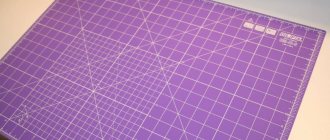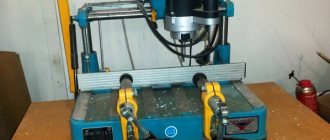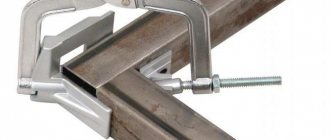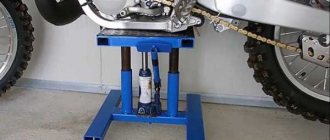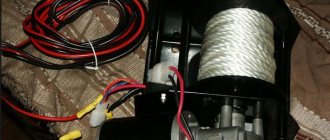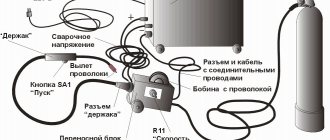Design features
The operating principle of the cleaning device is based on the phenomenon of cavitation - the formation in liquids under the influence of ultrasonic waves of air bubbles that burst with strong impact.
The design of an ultrasonic bath (USB) includes the following parts:
- Bowl made of alloy or stainless steel. The standard volume (2 l) allows you to clean several items at the same time; if necessary, baths of 1, 10, 15 l are used.
- Frequency generator. It is a source of vibrations.
- Emitter. The main mechanism that converts electrical vibrations into mechanical ultrasonic frequencies (over 18 kHz).
- A heating element. Brings and maintains the temperature of the liquid at a given level.
After turning on the device, under the influence of ultrasonic vibrations emanating from the emitter, many air bubbles are formed throughout the entire volume of the liquid, which envelop the contaminated object. Purification occurs at the moment when the bubbles burst under the pressure of internal pressure.
The use of RAS allows you to clean products of the most complex configuration and reach places that are not accessible during manual processing. In a heated liquid, the process is accelerated, but the presence of a heating element is not necessary. The device is safe and can be used even in a living room.
Design Features
The main component of the system, the emitter, is responsible for the operation. Its purpose is to convert electrical energy into mechanical vibrations. The impact of energy occurs on the part through the wall of the device, as a result of which the cleaning process occurs. The ultrasonic bath includes a frequency generator, the device of which is responsible for generating waves by applying electrical vibrations.
Ultrasonic bath design
High-quality cleaning of parts is achieved by exposure to waves at a certain temperature. Heating elements control the temperature of the liquid in accordance with the specified parameters. Pulse operation requires control of processes occurring during ultrasonic processing of parts. Cleaning of parts is carried out in stages:
- the purified solution is poured into a container;
- the object is lowered, for better impact, stands are used so that the part is in the middle of the bowl;
- after turning on the device, bubbles form on the surface of the liquid;
- bubbles act on the part in hard-to-reach places, clearing dirt.
Processing of parts takes quite a long time, depending on the amount of contamination. Large quantities of deposits can be treated with ultrasound for up to 10 hours.
Application benefits
A device purchased or made by yourself has a number of advantages over mechanical impact on parts. The main positive aspects of using an ultrasonic bath:
- There is no waste of time, interaction with the part during the cleaning process is eliminated, only intermediate control is required.
- The chemical does not harm human health if certain conditions are met. It is enough to wear rubber gloves when in contact with the treated part.
- Mechanical cleaning cannot quickly and effectively get rid of plaque and dirt in hard-to-reach places. Ultrasound will help get to all the cracks and corners of the part without leaving any dirt.
- Exposure of a part to ultrasound reduces to zero the risk of resulting in a damaged part. Mechanical damage is excluded, which cannot be said about the mechanical cleaning method.
The scope of application of an ultrasonic bath is wide; the device is sold on special portals of household appliances or specialized retail outlets.
Scope of use of ultrasonic baths
Using RAS, hardened deposits, protective coatings from radio components formed during operation of various mechanisms before soldering, and deposits of a corrosive and oxidative nature are easily removed.
The device is therefore suitable for use in the following areas:
- Jewelry and restoration business. Plaque is removed from products in 20-40 minutes, even hard-to-reach places in jewelry of complex configuration are cleaned.
- Car services and printing enterprises. For a high degree of cleaning of equipment parts, mechanisms and components (injectors, carburetors, etc.).
- Medicine. Laboratory instruments are cleaned and sterilized in the RAS.
- Chemical industry. Ultrasonication acts as a catalyst for some reactions.
- Electronics. When repairing circuit boards that are easily damaged during mechanical cleaning.
- Optics and watch workshops. Small parts can be easily cleaned.
If you need an ultrasonic bath for home use, you don’t have to buy it—you can make the device yourself. Most often, at home, it is used to descale the heating elements of washing machines and other electrical appliances. The advantages of this method are that it saves time and there is no need to clean anything yourself, and there is also no need to fear that the product will be damaged after the procedure.
What is ultrasonic engine cleaning?
The essence of this method is that the object to be cleaned (in the case of an internal combustion engine, we are talking about engine parts) is placed in a container with liquid. This liquid can be simply water or a detergent solution.
Ultrasound is then passed through the liquid. In a liquid, the effect of cavitation, acoustic flow, sound pressure and sound-capillary effect occur, which together gives cavitation erosion. This type of erosion in simple terms means the destruction of contaminants.
The main role in cleaning is played by cavitation, which looks like boiling due to vaporization and instantaneous condensation with the appearance of many bubbles. Oscillations arise due to the conversion of electric current by the converter into mechanical oscillations of the same frequency.
Converters come in different types. They can be placed either in the bath itself or attached to its walls or even on the surface of the part being cleaned. There are also special small devices for precise cleaning of the surface of small parts.
Thus, it becomes clear that ultrasonic cleaning of engine parts helps remove old contaminants where one or another mechanical means simply cannot reach. For example, various holes and channels. In addition, there is no danger of mechanical damage to the part or its individual elements.
The advantages of ultrasonic engine cleaning are that:
- Parts made of any materials, any shape and configuration, channels, internal cavities are guaranteed to be cleaned;
- Not only carbon deposits and chemical deposits are easily removed, but also rust;
- Saves time that is usually spent on washing in the usual way;
- Noticeable savings on detergent consumption were noted;
- Constant human participation is not required; just start the bath;
- After ultrasonic washing, engine parts do not require additional cleaning. As a last resort, you will have to wipe off any remaining dirt using a rag or a soft brush (brush).
What materials and tools are needed
It is not difficult to design a RAS, but before assembly it is necessary to prepare all the parts that will be needed during the work process. First, a board is made according to a special design. Using a soldering iron, all electrical elements of the structure will be connected into a circuit.
List of required materials:
- Metal vessel. The basis of the entire design, you can use a bowl or a small (1-2 liter) stainless steel pan.
- A container made of dielectric (ceramics or porcelain). Must be placed in a metal container and have a smooth surface without damage.
- Pulse transformer. Performs the function of amplifying and maintaining voltage at the required level.
- Round magnets. You will need 4-6 pieces, it doesn’t matter whether they are new or old (can be removed from unusable speakers).
- Non-conductive rod (eg glass).
- Magnetic coil with ferrite core.
- Plastic tube (2-3 cm in diameter). Designed for supplying and draining cleaning liquid.
- Epoxy adhesive. With its help, some parts are held together.
To ensure that the cleaning solution in the bath is continuously updated, the design is additionally equipped with a pump.
How to make an ultrasonic bath with your own hands
Before assembling an ultrasonic bath with your own hands, you need to understand what offers are available on the market.
There are several types of bathtubs offered by manufacturers:
- Portable devices are used in households, as well as when processing small products. The volume of the bowl varies from 1 to 2 liters; such a device costs from 5,000 to 20,000 rubles.
- Industrial modifications are used by large industries and car repair shops; they allow processing a large number of products at a time; the price can reach up to 50 thousand rubles.
DIY ultrasound generator
With certain skills, it is possible to make an ultrasonic bath with your own hands. If you have tools and access to accessories sold by radio parts stores, you can save up to 3 parts of the cost of a new device. For self-production you will need the following elements:
- Container for immersing products, made of stainless steel. It should stand firmly in place and have a slight rise for access to the bottom.
- Tube made of glass or plastic.
- A pump for pumping liquid is suitable for low power, its price is not so high.
- The magnet is circular in shape and can be removed from unused speakers.
- Ferrite core coil, ceramic or porcelain vessel.
- A pulse transformer is sold by points of sale of radio components, the price starts from 300 rubles.
Also, for work you will need liquid and power supply from a 220 Volt power supply.
Assembling an ultrasonic bath with your own hands
After preparing all the materials, you can begin assembling the ultrasonic bath with your own hands. The first step is to wind the ferrite wire onto a plastic tube, the rod can be in free form, a stable fastening is not required. A magnet is attached to the end of the rod, the result is a magnetic-friction emitter.
The next stage involves drilling holes with your own hands at the bottom of the bathtub container. The vessel is attached to a steel container, and holes are made nearby for supplying and draining liquid. The application will help to quickly carry out operations of supplying liquid to the bath; for draining, you can get by with a regular hose connected to the container.
A pulse-type transformer supplies high-voltage current, which increases the efficiency of the device. In the absence of access to radio components, you can remove the transformer from an unusable TV or telescopic monitor. After assembling and connecting all elements of the ultrasonic transformer, a test run is performed. During operation, it is important to follow safety rules, do not use the device without liquid, and do not touch the part during processing.
What liquid is used in an ultrasonic bath?
Liquid for ultrasonic baths can be found on sale less frequently than the device itself. Two types of solutions are used to influence the parts to be cleaned:
- A solution of a surfactant with water is used to clean precious metals.
- Alcohol based solution. The liquid, which is used to clean circuit boards and microcircuits, perfectly prevents the formation of corrosion on parts over time.
Acidic cleaners
There are various options for solutions that are used at home. Some owners of ultrasonic baths use diesel fuel or gasoline; working with such elements requires increased care, because they are explosive. It is possible to make a liquid yourself from the main components of a powder or detergent.
Rules for using ultrasonic baths
Operation of the device does not differ depending on its design or manufacturer. A bathtub made by yourself, or purchased on the market, requires compliance with certain safety regulations. Also, the mechanism can simply break if you do not follow the rules:
- Installation of the part is carried out only by wearing rubber gloves; this is due to the aggressive environment of the liquid, which can lead to allergies or other skin damage.
- Starting an empty device is strictly prohibited. When working with homemade structures, the ferrite rod can fly into pieces when exposed to high-frequency electricity. Purchased devices are equipped with a shutdown function when there is no liquid.
- Before starting, it is important to inspect the device body for signs of leaks and other damage.
It is important to monitor the technical condition of the electrical circuit; short circuits and overheating of the transformer cannot be ruled out during prolonged use of the ultrasonic bath. When working with small parts, it is possible to save processing time and liquid; just place the part in a glass with liquid, then to a device filled with ordinary water.
Self-assembly
First, the emitter is made. To do this, the wire from the coil is rewound onto a glass rod - about 20 turns of wire are made from the coil so that the ferrite rod remains free. Magnets are attached to its end.
The ceramic container is fixed on a metal base. A hole is drilled in the center at the bottom of the bath into which the emitter is inserted. It must be powered from the network through a pulse transformer, which can be removed from an old TV or monitor. It is also necessary to drill holes for supplying and draining liquid and insert tubes into them.
After connecting the power source to the circuit, liquid is poured into the RAS for a test run of the device. To perform a quick test, use thin foil. A piece of material is placed in the bath and the homemade device is turned on. If it is assembled correctly, then the foil will begin to quickly deteriorate in places where it is folded.
Fluid selection
Solutions complement the action of ultrasonic waves and are selected depending on the application of the bath.
Tools that can be used:
- Alcohol-based - Zestron-FA, Flux-off, Solins-us, Vega. Used for cleaning printed circuit boards, incl. from mobile phones.
- Cleaners with surfactants (surfactants) on a water or alkaline basis. There are universal and specialized ones.
- Concentrated shampoos - Creolan, Economic. Used for gentle cleaning and disinfection in optics, medicine and dentistry.
In auto repair shops, metal cleaners and sometimes kerosene or gasoline mixtures are added to RAS, but it is better not to use them due to the risk of fire. Practicing craftsmen use different options - white spirit, distilled water, alcohol, descaling agents. Rust is removed with an aqueous solution of phosphoric acid.
Rules for operating a homemade device
When using a bathtub you made yourself, you must follow safety rules when working with electrical appliances. You can only place objects in the solution by protecting your hands with rubber gloves. Otherwise, the aggressive environment may damage the skin or cause an allergic reaction.
Before starting, the RAS bowl is inspected for damage and possible leaks. You cannot start the device if it is not filled with liquid at least 2/3 of the volume. In homemade structures, the ferrite rod may fall apart, so you need to check its condition before starting work.
The technical condition of the electrical circuit also requires checking - with prolonged use of the bath, short circuits and overheating of the transformer windings are possible. Small parts can be removed from contamination by placing them in a glass with a cleaning solution placed next to a RAS filled with clean water.


